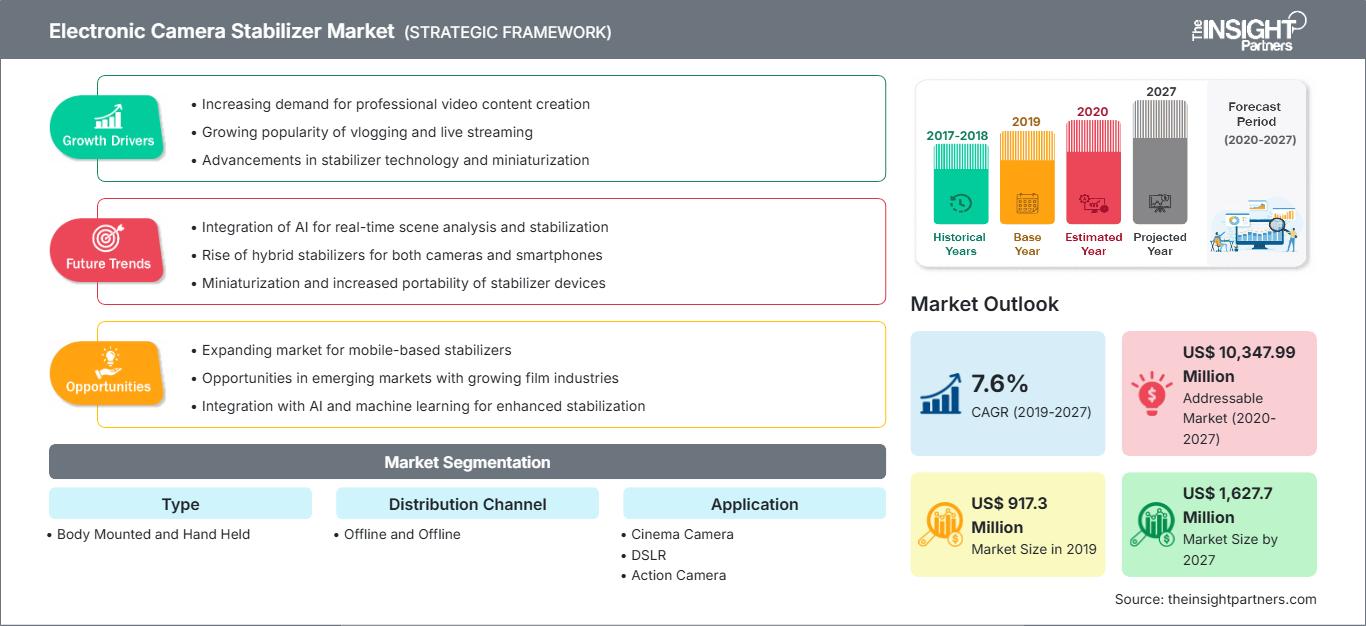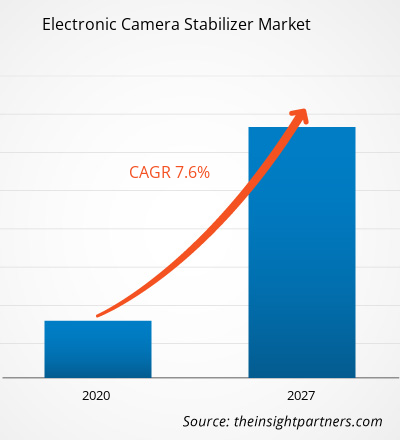Il mercato degli stabilizzatori elettronici per fotocamere è stato valutato a 917,3 milioni di dollari nel 2019 e si prevede che raggiungerà i 1.627,7 milioni di dollari entro il 2027; si prevede una crescita a un CAGR del 7,6% dal 2019 al 2027.
Uno stabilizzatore per fotocamere è un accessorio che riduce la sfocatura da movimento per catturare fotografie e video nitidi. Inizialmente, i fotografi professionisti utilizzavano gli stabilizzatori per fotocamere nel settore dei media e del broadcasting; tuttavia, ora hanno guadagnato popolarità tra i piccoli registi e i creatori di contenuti online. Negli ultimi decenni, il settore globale dell'intrattenimento e dei media ha registrato una crescita significativa, attribuibile all'aumento della produzione di diversi generi di contenuti video, sia in TV che sul grande schermo. I rapidi cambiamenti tecnologici, il comportamento dei consumatori e i modelli di business hanno cambiato il modo in cui i consumatori desiderano vivere e pagare l'intrattenimento e i media. I leader di questo settore si concentrano anche sulla creazione di aziende e marchi incentrati sui fan per produrre attivamente contenuti eccezionali. Di conseguenza, spendono/investono in tecnologie e attrezzature come immagini generate al computer (CGI) ed effetti visivi (VFX), nonché in una varietà di telecamere e periferiche, inclusi gli stabilizzatori per telecamere.
Inoltre, la quantità di contenuti online è aumentata negli ultimi anni. Ciò è dovuto alla crescente penetrazione di Internet e all'impatto dei social media sui consumatori. L'aumento del tempo medio di navigazione tra la popolazione odierna ha reso piattaforme come YouTube e Instagram redditizie, e questo ha attirato una forte concorrenza tra i creatori di contenuti. Per rimanere competitivi, i creatori di contenuti hanno iniziato a investire massicciamente in telecamere e periferiche, come gli stabilizzatori per telecamere, per offrire video di alta qualità. Questo crescente investimento ha spinto le vendite di telecamere e periferiche per telecamere e ha influenzato indirettamente la crescita degli stabilizzatori per telecamere nel mercato globale. Tuttavia, l'uso di telecamere e periferiche per telecamere non si limita al settore dell'intrattenimento e dei media: gli stabilizzatori per telecamere sono ampiamente utilizzati anche nel settore degli eventi grazie alla maggiore convenienza delle telecamere e dei relativi accessori e alle crescenti aspettative dei consumatori in termini di qualità video. Oggigiorno, le persone spendono molto per catturare le cerimonie nuziali con registrazioni video di alta qualità. Pertanto, gli operatori del settore dell'organizzazione di eventi hanno iniziato a investire in attrezzature fotografiche di alta qualità per soddisfare la domanda. Questo, a sua volta, sta guidando la crescita del mercato globale degli stabilizzatori per fotocamere.
Il Nord America è leader nel mercato degli stabilizzatori elettronici per fotocamere con la quota di mercato più significativa al mondo, seguito da Europa e Asia-Pacifico. Si prevede che la crescente adozione di dispositivi elettronici di consumo come videocamere, fotocamere digitali e smartphone, e la maggiore capacità di spesa dei clienti, stimoleranno la domanda di stabilizzatori per fotocamere nella regione durante il periodo di previsione.
Il mercato globale degli stabilizzatori elettronici per fotocamere è segmentato in base a tipologia, applicazione e canale di distribuzione. In base alla tipologia, il mercato è ulteriormente suddiviso in fotocamere montate sul corpo e portatili. In base all'applicazione, il mercato è ulteriormente suddiviso in videocamere cinematografiche, reflex digitali, action camera e smartphone. In base al canale di distribuzione, il mercato è ulteriormente suddiviso in offline e online. Gli stabilizzatori per fotocamere sono progettati per fornire stabilità durante la registrazione video di un oggetto in movimento. La significativa crescita di settori correlati come cinema e intrattenimento, sport, fotografia professionale, viaggi subacquei e sport alimenta la domanda di stabilizzatori per fotocamere. I principali utenti finali del prodotto includono videografi professionisti e amatoriali. L'obiettivo dei produttori è integrare tecnologie avanzate e sviluppare nuovi design per adattarsi a fotocamere compatte e ad alta resistenza. Gli stabilizzatori per fotocamere sono una delle tipologie di attrezzature essenziali utilizzate durante la realizzazione di film, video musicali, documentari e varie altre forme di intrattenimento. Si prevede inoltre che i continui sviluppi, come l'elevata penetrazione di 4K, 6K e 8K nella produzione di film e webserie nel settore dei media e dell'intrattenimento, aumenteranno la domanda di fotocamere e stabilizzatori avanzati. Uno dei fattori significativi che avrà un impatto positivo sul mercato globale degli stabilizzatori per fotocamere nei prossimi anni sarà il crescente utilizzo di stabilizzatori per fotocamere per la fotografia d'azione. La crescente popolarità dell'industria cinematografica ha portato a un aumento dei livelli di creatività nella cinematografia. I professionisti si cimentano sempre più spesso in riprese fantasiose che coinvolgono movimenti perfetti e utilizzano obiettivi specializzati per catturare immagini creative. I fotografi professionisti utilizzano attrezzature specifiche come rig e stabilizzatori per ottenere scatti perfetti e valorizzare il lato artistico. Pertanto, la crescente domanda di fotografia d'azione sta spingendo l'uso di stabilizzatori per fotocamere.
Personalizza questo rapporto in base alle tue esigenze
Potrai personalizzare gratuitamente qualsiasi rapporto, comprese parti di questo rapporto, o analisi a livello di paese, pacchetto dati Excel, oltre a usufruire di grandi offerte e sconti per start-up e università
Mercato degli stabilizzatori elettronici per fotocamere: Approfondimenti strategici

-
Ottieni le principali tendenze chiave del mercato di questo rapporto.Questo campione GRATUITO includerà l'analisi dei dati, che vanno dalle tendenze di mercato alle stime e alle previsioni.
L'industria cinematografica è considerata una delle categorie più grandi e redditizie dell'industria dell'intrattenimento globale. Il settore produce diversi film ogni anno, con Hollywood che rappresenta il maggiore contributore mondiale all'industria cinematografica. L'industria cinematografica cinese è una delle più grandi al mondo, con un fatturato di circa 6,6 miliardi di dollari nel 2016. Si prevede che queste promettenti prospettive per l'industria cinematografica e dell'intrattenimento stimoleranno la domanda di stabilizzatori elettronici per ottenere riprese e video perfetti. La crescita del mercato può essere attribuita alla maggiore produzione di diversi generi di contenuti video, sia in TV che sul grande schermo. I rapidi cambiamenti tecnologici, il comportamento dei consumatori e i modelli di business hanno modificato il modo in cui i consumatori desiderano vivere e pagare l'intrattenimento e i media. I leader di questo settore si concentrano anche sulla creazione di aziende e marchi incentrati sui fan per produrre attivamente contenuti eccezionali. Di conseguenza, investono/investono in tecnologie e attrezzature come immagini generate al computer (CGI) ed effetti visivi (VFX), nonché in una varietà di telecamere e periferiche diverse, inclusi gli stabilizzatori per telecamere.
Approfondimenti di mercato basati sulla tipologia
In base alla tipologia, il mercato degli stabilizzatori elettronici per telecamere è segmentato in: corpo macchina e portatili. Nel 2019, il segmento portatile ha guidato il mercato per tipologia di stabilizzatori elettronici per telecamere. Vantaggi come la leggerezza, la facilità di trasporto e il crescente utilizzo per la produzione cinematografica e le riprese di sport d'azione contribuiranno alla crescita del mercato degli stabilizzatori per telecamere portatili nei prossimi anni.
Approfondimenti di mercato basati sul canale di distribuzione
In base al canale di distribuzione, il mercato degli stabilizzatori elettronici per telecamere è segmentato in: offline, online. Il canale di vendita offline offre ai propri clienti stabilizzatori per telecamere di persona in un ufficio o negozio di proprietà o in affitto dall'azienda. I negozi fisici hanno avuto difficoltà a competere con la maggior parte delle aziende online come Amazon.com Inc. Il canale offline è leader in termini di quota di mercato per canale di vendita; tuttavia, si prevede che il segmento del canale online acquisirà una quota di mercato elevata nel periodo di previsione.
Approfondimenti di mercato basati sulle applicazioni
In base all'applicazione, il mercato degli stabilizzatori elettronici per fotocamere è segmentato in: Videocamere Cinematografiche, DSLR, Action Camera e Smartphone. Il segmento DSLR ha guidato il mercato per applicazione degli stabilizzatori elettronici per fotocamere. Questa sezione comprende fotocamere Mirrorless e DSLR. Gli stabilizzatori per fotocamere aiutano a catturare scatti con inseguimento prolungato e a rendere più elaborati zoom e panoramiche. Conferiscono un aspetto più professionale agli scatti realizzati con reflex digitali a obiettivo singolo (DSLR). Alcuni stabilizzatori per fotocamere, in base al peso, hanno una capacità di carico sufficiente per trasportare fotocamere DSLR.
Lo sviluppo del prodotto è la strategia comunemente adottata dalle aziende per espandere il proprio portafoglio prodotti. SZ DJI Technology Co., Ltd., Ikan Corporation, edelkrone, Gudsen Technology Co., Ltd. (Moza) e Zhiyun, tra gli altri, sono i principali attori che implementano strategie per ampliare la base clienti e acquisire una quota significativa nel mercato globale degli stabilizzatori elettronici per fotocamere, il che a sua volta consente loro di mantenere il proprio marchio. Alcuni dei recenti sviluppi chiave sono:
- Nel 2020, Zhiyun ha stretto una partnership con Huawei, un'azienda di telecomunicazioni con sede in Cina, per creare un'esperienza di vlogging migliore con l'aiuto degli stabilizzatori gimbal dell'azienda e degli smartphone Huawei.
- Nel 2019, Gudsen Technology Co. Ltd. ha introdotto il suo stabilizzatore a 3 assi MOZA Mini-P, compatibile con diversi dispositivi, tra cui action cam, smartphone, fotocamere compatte e fotocamere mirrorless leggere. Ha una portata di 900 g, fino a 20 ore di autonomia, un controllo della fotocamera migliorato e modalità di scatto innovative. Il prodotto è ideale per avventure, viaggi e riprese cinematografiche.
Le tendenze regionali e i fattori che influenzano il mercato degli stabilizzatori elettronici per fotocamere durante il periodo di previsione sono stati ampiamente spiegati dagli analisti di The Insight Partners. Questa sezione illustra anche i segmenti e la geografia del mercato degli stabilizzatori elettronici per fotocamere in Nord America, Europa, Asia-Pacifico, Medio Oriente e Africa, America Meridionale e Centrale.
Ambito del rapporto di mercato degli stabilizzatori elettronici per fotocamere
| Attributo del rapporto | Dettagli |
|---|---|
| Dimensioni del mercato in 2019 | US$ 917.3 Million |
| Dimensioni del mercato per 2027 | US$ 1,627.7 Million |
| CAGR globale (2019 - 2027) | 7.6% |
| Dati storici | 2017-2018 |
| Periodo di previsione | 2020-2027 |
| Segmenti coperti |
By Tipo
|
| Regioni e paesi coperti |
Nord America
|
| Leader di mercato e profili aziendali chiave |
|
Densità degli operatori del mercato degli stabilizzatori elettronici per fotocamere: comprendere il suo impatto sulle dinamiche aziendali
Il mercato degli stabilizzatori elettronici per fotocamere è in rapida crescita, trainato dalla crescente domanda degli utenti finali, dovuta a fattori quali l'evoluzione delle preferenze dei consumatori, i progressi tecnologici e una maggiore consapevolezza dei vantaggi del prodotto. Con l'aumento della domanda, le aziende stanno ampliando la propria offerta, innovando per soddisfare le esigenze dei consumatori e sfruttando le tendenze emergenti, alimentando ulteriormente la crescita del mercato.

- Ottieni il Mercato degli stabilizzatori elettronici per fotocamere Panoramica dei principali attori chiave
- Montati sul corpo
- Portatili
Per canale di distribuzione
- Offline
- Online
Per applicazione
- Cinema
- DSLR
- Action Camera
- Smartphone
Profili aziendali
- Edelkrone
- Glidecam Industries, Inc.
- Gudsen Technology Co., Ltd.
- Ikan Corporation
- Letus Corporation
- NINGBO EIMAGE STUDIO EQUIPMENT CO., LTD
- Rhino Camera Gear
- SZ DJI Technology Co., Ltd.
- Tilta Technology Co., Ltd
- Zhiyun
- Analisi storica (2 anni), anno base, previsione (7 anni) con CAGR
- Analisi PEST e SWOT
- Valore/volume delle dimensioni del mercato - Globale, Regionale, Nazionale
- Industria e panorama competitivo
- Set di dati Excel
Report recenti
Testimonianze
Motivo dell'acquisto
- Processo decisionale informato
- Comprensione delle dinamiche di mercato
- Analisi competitiva
- Analisi dei clienti
- Previsioni di mercato
- Mitigazione del rischio
- Pianificazione strategica
- Giustificazione degli investimenti
- Identificazione dei mercati emergenti
- Miglioramento delle strategie di marketing
- Aumento dell'efficienza operativa
- Allineamento alle tendenze normative






















 Ottieni un campione gratuito per - Mercato degli stabilizzatori elettronici per fotocamere
Ottieni un campione gratuito per - Mercato degli stabilizzatori elettronici per fotocamere